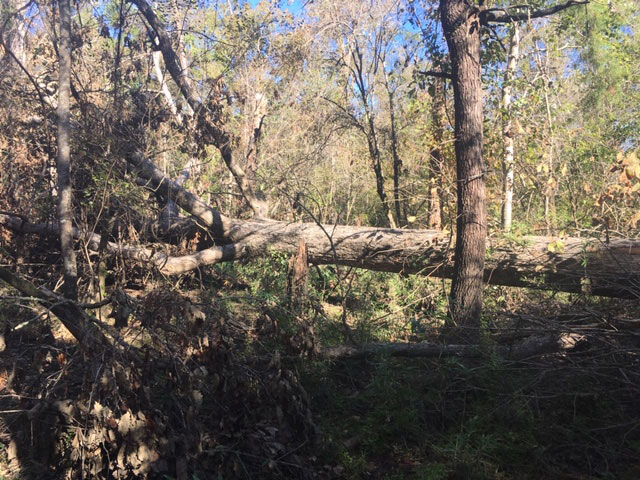
Hurricanes in 2020 and 2021 greatly impacted the Bayou State. So what can a landowner do to improve the landscape for the wildlife?
The past two years have been tough for Louisiana. Covid has taken a toll on the human population. Hurricanes have taken a toll on the habitat and the forests. Hurricanes Laura and Delta swept into southwest Louisiana and left an immeasurable path of timber destruction as it moved northward from one end of the state to the other in 2020. Then in 2021, Hurricane Ida moved northward from the Gulf into southeast Louisiana damaging more than 167,000 acres of trees.
The Louisiana Department of Agriculture and Forestry along with the USDA Forest Service estimated that 4.9 million tons of pine and 6.5 million tons of hardwood were destroyed by the storm, resources with a market value of 181.2 million dollars.
While it is always desirable for landowners to salvage the downed timber, this is not always possible. During a normal timber operation, trees are methodically harvested. Cutting machines cut the trees in rows and they are dragged to a logging site where they are loaded on trucks and hauled to the mills. Hurricanes drop trees in haphazard fashion across the landscape and logging downed timber is difficult and challenging.
Slow process
A cutting machine that is able to cut a tree laying on the ground is needed and most logging companies do not have this expensive equipment. A salvage process is slow due to this challenging work and it is impossible to harvest the amount of timber secured during a normal timber operation. And then there is the problem with winter weather. Heavy rainfall will quickly shut an operation down.
Small landowners who experienced timber loss on their property are prob-ably out of luck concerning salvaging downed trees for the timber market. There would be opportunity to cut the downed trees for firewood or for lumber for special projects and needs. The problem with cutting trees up for firewood is that everyone has downed trees and anyone who wants firewood can get all he wants. On our small property we had two large oaks and a pecan fall in food plot areas; it took several weeks to cut and clear off the plots and, to date, only two and one-half truck loads of wood have been hauled off. Most of it, even though it is cut and ready to split, will probably be left to rot and decay.
Recovery from such a catastrophic event will be slow.
The Pearl River Wildlife Management Area was hit hard by Hurricane Katrina in 2005 and for years it was extremely difficult for hunters to get into the woods and hunt. Hurricane Ida did not do the damage to the area that Katrina did, but the area did suffer loss of very desirable wildlife trees. Some of the large cow oaks that had survived Katrina did not fare well during Ida and are now on the ground in the area where I hunt. Cow oaks are a very desirable acorn tree for deer. With Katrina, we found that trees that did not fall suffered heavy upper limb damage and within a few years had died. The same will happen after the latest storms.
What should you do?
From a wildlife perspective, what should a landowner do? This first thing is to take inventory of the damage. How many acres were impacted and what species were involved. Heavy rainfall occurred in the state in the spring and summer in Louisiana and because of this, the ground was saturated with water and with the strong hurricane winds, many oaks and other hardwoods fell to the ground.

With regard to wildlife, replacement of mast bearing trees is a must. So, with this in mind, consideration should be given to determine if planting with some new oak species would be beneficial. If your property has mainly red oak species, now would be the time to consider white oak species such as white oaks or cow oaks. Chestnuts and chinquapins are also desirable mast species to have on the landscape. No doubt there is regeneration coming up from the mature trees that were dropping acorns and this would be documented by the inventory. If mature trees were heavily damaged and within a few years might die and fall, now would be the time to cut and put them on the ground so they do not fall and damage the regeneration. If the upper limb damage of a mast producing oak is greater than fifty percent, the tree probably will not be able to produce enough food to stay alive and could die within two to three years.
On the positive side downed trees do provide cover for wildlife. From a deer standpoint browse is a must for desirable growth and development. The damage from Ida was severe, but somewhat scattered across the landscape. If a one to three acre site was heavily damaged it might be beneficial to just leave it alone and let it provide food and cover. If your property is lacking in wildlife plantings, now would be the time to finish clearing and cleaning it up and put it into wildlife plantings.
Recovery from a storm is a slow process. Active involvement from the landowner is a must to keep the property productive for wildlife. I will not live to see the benefit from the tree planting and restoration work that I am doing, but there are four grandsons living across the field from us who will!


